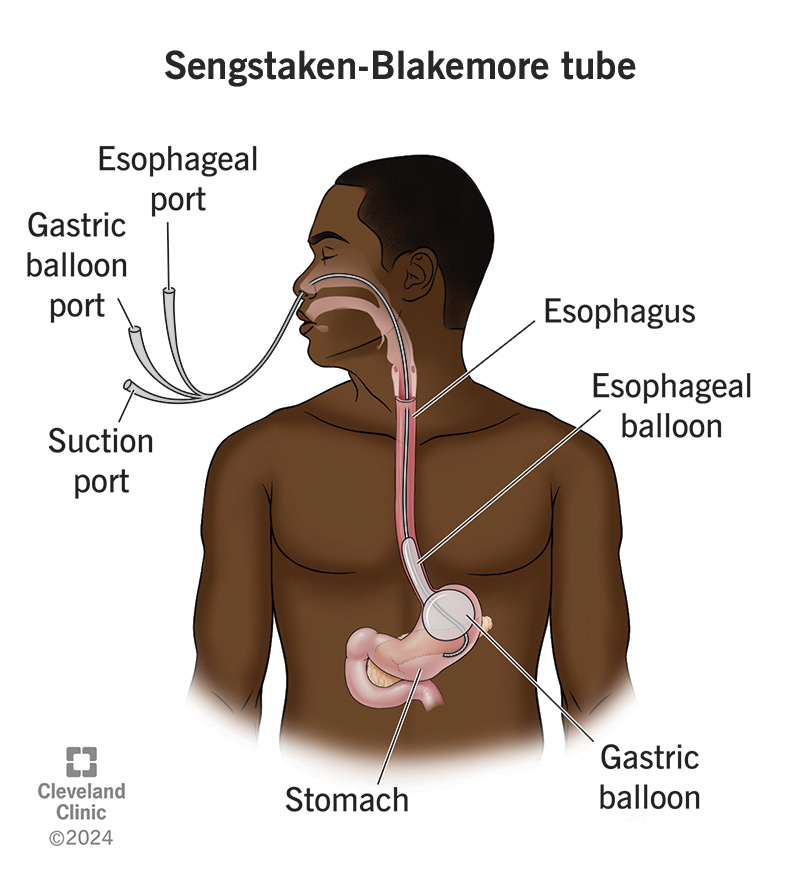A Sengstaken-Blakemore tube is a device that stops bleeding from your esophagus or stomach. Healthcare providers use it as a last-resort option to temporarily stop life-threatening bleeding.
Advertisement
Cleveland Clinic is a non-profit academic medical center. Advertising on our site helps support our mission. We do not endorse non-Cleveland Clinic products or services. Policy

A Sengstaken-Blakemore tube (SB tube) is a device that healthcare providers place in your nose or mouth to temporarily control swollen veins in the lining of your esophagus (esophageal varices) or stomach (gastric varices) that can lead to internal bleeding or other stomach or esophageal bleeding (hemorrhaging).
Advertisement
Cleveland Clinic is a non-profit academic medical center. Advertising on our site helps support our mission. We do not endorse non-Cleveland Clinic products or services. Policy
Surgeons use it in emergencies as a last resort — when other options either aren’t available or don’t work. It’s rarely used today because we know that endoscopy and medications are more effective at controlling life-threatening bleeding.
An SB tube is a long, flexible tube with a gastric and esophageal balloon on one end and three ports or channels on the other end. The ports each have a unique function:
Your provider inserts the ends that contain the balloons inside your nose or mouth and down your esophagus. They’ll use X-ray to ensure the tube is in the right place.
From there, your provider fills the gastric balloon through the gastric balloon port while it’s inside your stomach. Likewise, they fill the esophageal balloon through the esophageal balloon port.
The two filled balloons work by putting pressure on the blood vessels in your stomach or esophagus that are bleeding. Your provider can also add extra weight to the tube, which adds additional pressure. This pressure works to stop the bleeding. The suction port removes fluid and blood from your stomach.
Advertisement
The SB balloon stays in place until the bleeding stops. This can take several hours. Then, your provider slowly takes the air out of the balloons and pulls out the tube. There’s a 50% chance the bleeding will start again once your provider takes the SB tube out. Your provider will be prepared with another treatment to stop the bleeding if this should happen.
One of the disadvantages of SB tubes is that they can be hard to position. A possible complication is that your provider can accidentally insert the tube into your trachea, which will affect your ability to breathe. Healthcare providers avoid this risk by inserting a tube down your throat that helps you breathe (intubation).
Other complications from incorrect SB tube insertion are:
If you have any of the following, your provider shouldn’t use an SB tube:
Even though SB tubes are a last-resort option for emergency medicine providers, they’re one of the few methods to stop esophageal hemorrhages.
It can feel scary to know you or a loved one needed an SB tube to control internal bleeding. Most of us would prefer not to ever need one, but it has an important use. If you did need an SB tube, know your healthcare provider used it as a potentially lifesaving treatment. They work hard to make sure these types of procedures are done safely. If you have questions about how an SB tube works or are concerned about complications from it, please talk to your healthcare team.
Advertisement
Having an endoscopy can be lifesaving. Cleveland Clinic’s providers will help you feel comfortable with the process so you can get the care you need.

Last reviewed on 09/29/2025.
Learn more about the Health Library and our editorial process.